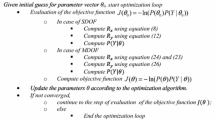Abstract
System identification in recent years with the development of dynamic testing of structures has become one of the useful methods for structural health monitoring and damage detection and also finite element model updating. Identification of structural dynamic parameters is performed by using excitation–response data and includes physical parameters such as mass, stiffness and damping matrices and/or modal parameters such as natural frequencies, damping ratios and modal shapes. This paper presents a new method to identify the dynamical parameters of shear building based on continuous-time state-space estimation using block pulse functions and least-squares technique. Block pulse functions are a set of orthogonal functions with piecewise constant values and useful tools in analysis, identification and system science. Assuming that the input–outputs data of the original system are known, their block pulse coefficients can be calculated by numerical methods, and using block pulse operational matrix, state-space equations of dynamical system are transformed into block pulse regression equations. Based on these equations, the plant matrix is estimated using least-squares algorithm. Then, the physical and modal parameters of structure are identified based on eigenmode data of the estimated plant matrix. To prove the validity and feasibility of the proposed method, numerical simulation of a shear building which is equipped with sensors on all floors and excited by four different normally distributed random signals and an earthquake is presented. The results reveal the proposed method can be beneficial in structural identification with less computational expenses and high accuracy.



Similar content being viewed by others
References
Allemang RL, Brown DL (1983) A correlation coefficient for modal vector analysis. In: Proceedings of the 1st international modal analysis conference USA 110–116
Alvin KF, Park KC (1994) Second-order structural identification procedure via state-space-based system identification. AIAA J 32(2):397–406
Babolian E, Masouri Z (2008) Direct method to solve Volterra integral equation of the first kind using operational matrix with block-pulse functions. J Comput Appl Math 220(1):51–57. doi:10.1016/j.cam.2007.07.029
Bouafoura MK, Moussi O, Braiek NB (2011) A fractional state space realization method with block pulse basis. Signal Process 91:492–497. doi:10.1016/j.sigpro.2010.04.010
De Callafon RA, Moaveni B, Ponte JP, He X, Udd E (2008) General realization algorithm for modal identification of linear dynamic systems. J Eng Mech 134(9):712–722. doi:10.1061/(ASCE)/0733-9399
Deb A, Sarkar G, Sen SK (1994) Block pulse functions the most fundamental of all piecewise constant basis functions. J Syst Sci 25:351–363. doi:10.1080/00207729408928964
Garevski M (2013) Earthquakes and health monitoring of civil structures. Springer, New York
Ghaffarzadeh H, Younespour A (2014) Active tendons control of structures using block pulse functions. Struct Control Health Monit 21:1453–1464. doi:10.1002/stc.1656
Ho BL, Kalman RE (1966) Effective construction of linear state-variable models from input–output functions. Regelungstechnik 14(12):545–592
James GH, Carne TG, Lauffer JP (1993) The natural excitation technique for modal parameters extraction from operating wind turbines. SAND92-1666, UC-261, Sandia National Laboratories, Sandia, New Mexico
Jiang ZH, Schaufelberger W (1992) Block pulse functions and their applications in control systems. Springer, Berlin
Juang JN, Pappa RS (1985) An eigensystem realization algorithm for modal parameter identification and model reduction. Guid Control Dyn 8:620–627
Juang JN, Cooper JE, Wright JR (1988) An eigensystem realization algorithm using data correlations (ERA/DC) for modal parameter identification. Control Theory Adv Technol 4(1):5–14
Ljung L (1999) System identification: Theory for the user, 2nd edn. Prentice-Hall, Upper Saddle
Lus H, De Angelis M, Betti R, Longman RW (2003) Constructing second- order models of mechanical systems from identified state space realizations. Part I: Theoretical Discussions. Eng Mech 129(5):477–488
Maleknejad K, Khodabin M, Rostami M (2011) Numerical solution of stochastic Volterra integral equations by a stochastic operational matrix based on block pulse functions. Math Comput Model 55:791–800. doi:10.1016/j.mcm.2011.08.053
Pacheco RP, Steffen v Jr (2002) Using orthogonal functions techniques for identification and sensitivity analysis of mechanical system. J Vib Control 8:993–1021. doi:10.1177/1077546029583
Palanisamy KR, Bhattacharya DK (1981) System identification via block-pulse function. Syst Sci 12:643–647
Park JH (2015) Approximation algorithm for multi-input and multi-output system using generalized block pulse integrational matrices. Control Autom 8(6):317–326. doi:10.14257/ijca.2015.8.6.31
Peeters B, De Roeck G (2001) Stochastic system identification for operational modal analysis: a review. J Dyn Syst Meas Control 123(4):659–667. doi:10.1115/1.1410370
Sannuti P (1977) Analysis and synthesis of dynamic system via block pulse functions. IEEE Proc 124:569–571
Sinha Nk, Zhou QI-JIE (1984) State estimation using block pulse functions. J Syst Sci 15(4):341–350. doi:10.1080/00207728408926567
Sirca GF Jr, Adeli H (2012) System identification in structural engineering. Sci Iran 19(6):1355–1364. doi:10.1016/j.scient.2012.09.002
Tang Y, Liu H, Wang W, Lian Q, Guan X (2015) Parameter identification of fractional order systems using block pulse functions. Signal Process 107:272–281. doi:10.1016/j.sigpro.2014.04.011i
Van Overschee P, de Moor B (1996) Subspace identification for linear systems. Kluwer Academic Publishers, Massachusetts. doi:10.1007/978-1-4613-0465-4
Younespour A, Ghaffarzadeh H (2014) Structural active vibration control using active mass damper by block pulse functions. J Vib Control 21(14):2787–2795
Young PC, Schaufelberger W (2011) Recursive estimation and time-series analysis. Springer, Berlin. doi:10.1007/978-3-642-21981-8
Author information
Authors and Affiliations
Corresponding author
Rights and permissions
About this article
Cite this article
Hosseini Ajorloo, Y., Ghaffarzadeh, H. Identification of Structural Dynamic Parameters Using Block Pulse Functions and Recursive Least-Squares Algorithm. Iran J Sci Technol Trans Civ Eng 41, 149–158 (2017). https://doi.org/10.1007/s40996-017-0057-0
Received:
Accepted:
Published:
Issue Date:
DOI: https://doi.org/10.1007/s40996-017-0057-0




